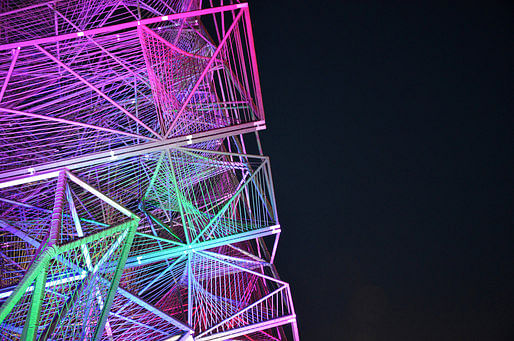
L.A. architectural practice Oyler Wu Collaborative designed "The Cube" from a fundamental notion: to challenge the spatial and geometric properties of the cube, a geometric form long regarded as a basic element for design, art, and science. Built for the 2013 Beijing Biennale, the sculpture transforms a solid idea into an abstract piece -- and just a really cool-looking installation that surely makes a nifty backdrop for picture-taking.
We'll let Oyler Wu explain the intricate details behind the project:
"The Cube was designed with the intention of challenging the perceptual reading of the volumetric object. Beginning with this iconic and basic geometry, the overall scheme is designed to maintain the clear presence of the six-sided object in space.
Closer inspection of the scheme, however, is intended to reveal a more nuanced and experiential spatial effect - one that moves beyond the object and offers a radically different reading. Approximately sixteen meters tall and constructed of painted steel and rope, the Cube capitalizes directly on the inherent spatial characteristics of line, existing as a more ephemeral framework of complex geometric patterns that transform as they move through space."

"Despite the density and apparent solidity of the object when viewed from afar, one can experience several large voids that move up through the Cube, offering views into and through the object. The voids are viewed from directly below the object, and are meant to further the immersive dimension of the piece." "The design process began with a simple two-dimensional plane with a series of patterns, consisting of line-work, drawn across the surface. That surface is then repeated in space, creating six planes, each offset a distance of 3 meters from one another, forming a perfect cube.
"The design process began with a simple two-dimensional plane with a series of patterns, consisting of line-work, drawn across the surface. That surface is then repeated in space, creating six planes, each offset a distance of 3 meters from one another, forming a perfect cube.
Moving perpendicular to the planes is a series of surfaces made of lines, adapting, twisting and contorting in order to connect the six planes together. Cavities of space are formed by these continuously warping planes that reach deep into the volume of the cube. Eventually, the planes spill out of the volume, lifting the volume into the air, and becoming structural supports for the now precariously tilted volume of lines."
"By using a semi-repetitious field of twisting 'surfaces,' the scheme moves back and forth between complex field and coherent geometric object. Ultimately, we're interested in the transcendence of line into a completely engulfing experience - one that can be occupied as a kind of three-dimensional drawing."
"This ambition is aimed at creating an evolving experiential effect- where one’s understanding of it from the outside in moves from a geometrical object, to a sense of enclosure, to a dynamic field of shifting trajectories."
Credits:
Project Team: Dwayne Oyler, Jenny Wu, Lung Chi Chang, Dustin Columbatto, Eric Lalone, Huy Le, Shawn Rassekh, Sanjay Sukie, Yaohua Wang
Structural Engineering: Nous Engineering, Matt Melnyk
Lighting Designer: Lux Populi
Photography: Jason Wheeler, Lam Kaiming Lin
Click the thumbnails below for more images.
No Comments
Block this user
Are you sure you want to block this user and hide all related comments throughout the site?
Archinect
This is your first comment on Archinect. Your comment will be visible once approved.